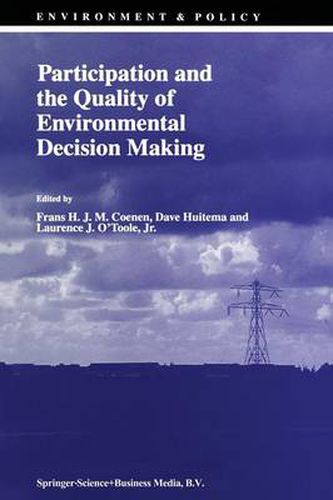Readings Newsletter
Become a Readings Member to make your shopping experience even easier.
Sign in or sign up for free!
You’re not far away from qualifying for FREE standard shipping within Australia
You’ve qualified for FREE standard shipping within Australia
The cart is loading…






This title is printed to order. This book may have been self-published. If so, we cannot guarantee the quality of the content. In the main most books will have gone through the editing process however some may not. We therefore suggest that you be aware of this before ordering this book. If in doubt check either the author or publisher’s details as we are unable to accept any returns unless they are faulty. Please contact us if you have any questions.
It is clear that our society must become a more sustainable one. To that end, we must change both our production and our consumption patterns. Some argue that this implies the abolition of democratic processes, and thus of citizens’ participation in environmental policy. Others argue the opposite: the only way to avoid impending environmental disaster is by engaging in common deliberation and contemplation. Is participation, then, a negative force or not?
This volume is one of the first coordinated attempts to study the relationship between democratic, participatory forms of decision making and the quality of environmental decisions. The central question is how can the normatively desirable practice of participatory decision making be combined with an effective approach to environmental issues?
Guided by a theoretical introduction by the editors, the 15 chapters deal with topics ranging from the scale of environmental problems, local agenda 21, infrastructural decisions, strategic planning, to environmental policy in developing countries. Three chapters are devoted to each of these broad themes. Each presents either a theoretical or an empirical argument about the central research question, shedding light on such issues as the measurement of decision quality, participation techniques, and the link between participation and decision quality, drawing on experience gained in Europe, North and South America, Asia, and Africa. The introductions to the individual parts of the book have been collectively written by the contributors, who represent a range of professional disciplines, including political science, public policy and planning.
$9.00 standard shipping within Australia
FREE standard shipping within Australia for orders over $100.00
Express & International shipping calculated at checkout
This title is printed to order. This book may have been self-published. If so, we cannot guarantee the quality of the content. In the main most books will have gone through the editing process however some may not. We therefore suggest that you be aware of this before ordering this book. If in doubt check either the author or publisher’s details as we are unable to accept any returns unless they are faulty. Please contact us if you have any questions.
It is clear that our society must become a more sustainable one. To that end, we must change both our production and our consumption patterns. Some argue that this implies the abolition of democratic processes, and thus of citizens’ participation in environmental policy. Others argue the opposite: the only way to avoid impending environmental disaster is by engaging in common deliberation and contemplation. Is participation, then, a negative force or not?
This volume is one of the first coordinated attempts to study the relationship between democratic, participatory forms of decision making and the quality of environmental decisions. The central question is how can the normatively desirable practice of participatory decision making be combined with an effective approach to environmental issues?
Guided by a theoretical introduction by the editors, the 15 chapters deal with topics ranging from the scale of environmental problems, local agenda 21, infrastructural decisions, strategic planning, to environmental policy in developing countries. Three chapters are devoted to each of these broad themes. Each presents either a theoretical or an empirical argument about the central research question, shedding light on such issues as the measurement of decision quality, participation techniques, and the link between participation and decision quality, drawing on experience gained in Europe, North and South America, Asia, and Africa. The introductions to the individual parts of the book have been collectively written by the contributors, who represent a range of professional disciplines, including political science, public policy and planning.